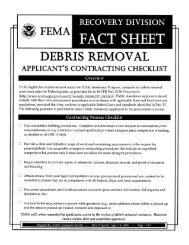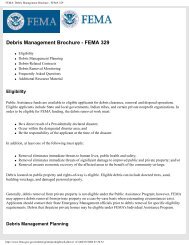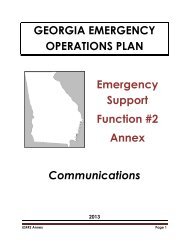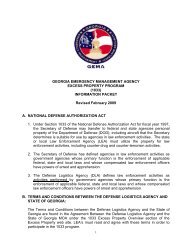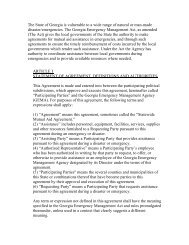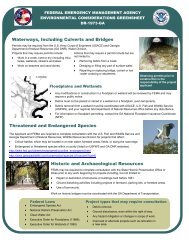Georgia Emergency Operations Plan - GEMA/Homeland Security
Georgia Emergency Operations Plan - GEMA/Homeland Security
Georgia Emergency Operations Plan - GEMA/Homeland Security
You also want an ePaper? Increase the reach of your titles
YUMPU automatically turns print PDFs into web optimized ePapers that Google loves.
have multiple layers of protection in place to mitigates equipment or network<br />
failures.<br />
In <strong>Georgia</strong>, the most common utilities failure occurs with electricity. High winds<br />
from thunderstorms have the potential to damage power lines and infrastructure,<br />
or cause trees to fall on power lines. Typically, damage is confined to localized<br />
areas, and utility crews can restore power within hours. Large-scale events,<br />
however, such as hurricanes or ice storms, have the potential to disrupt power for<br />
a widespread area for an extended period of time. In <strong>Georgia</strong>, between 2004<br />
and 2009, all major disturbances and unusual occurrences in the provision of<br />
electricity have been associated with natural hazards (thunderstorms, ice storms,<br />
tropical storms, and hurricanes) rather than a failure of the facility or network.<br />
Transportation Incidents<br />
<strong>Georgia</strong> is criss-crossed by an extensive transportation network featuring roads,<br />
highways, and rail lines. Hartsfield-Jackson International Airport in Atlanta has<br />
consistently ranked as the busiest or one of the most busy airports in the world. In<br />
addition, the Ports of Savannah and Brunswick handle significant container<br />
traffic throughout the year; in 2007, the Port of Savannah was ranked as the<br />
fourth-busiest and fastest-growing container terminal in the US. The extent of<br />
<strong>Georgia</strong>’s transportation network and intensity of activity raise the threat of<br />
potential transportation incidents. Most transportation incidents are confined to<br />
the roadway network and can be mitigated in hours. However, there is the<br />
potential for larger scale incidents with more wide-reaching impacts, such as an<br />
airplane crash, major train derailment, or port-related incident.<br />
Structural Collapse<br />
A structural collapse refers to: (a) the collapse of a multi-story office building,<br />
apartment, hotel, or similar building, or (b) the collapse of a major bridge or<br />
other transportation/infrastructure component. These events have high potential<br />
to cause multiple injuries or casualties. If a transportation facility is affected,<br />
movement of goods and people will be interrupted, and there may be major<br />
economic impact. Such buildings and facilities are located across the State.<br />
Structural collapses may occur due to natural events, such as a tornado,<br />
earthquake, or storm surge associated with a hurricane. Human error is also<br />
sometimes to blame. In June 2009, a parking deck in midtown Atlanta partially<br />
collapsed, causing extensive damage to vehicles. In 2008, a bridge at the<br />
Atlanta Botanical Gardens collapsed during construction, killing one worker and<br />
injuring 18 others.<br />
Radiological Release<br />
A release of radiological material may occur (a) from an incident at a nuclear<br />
power plant, or (b) during shipment of transuranic waste through <strong>Georgia</strong>.<br />
<strong>Georgia</strong> Power, a subsidiary of Southern Company, operates two nuclear plants<br />
in <strong>Georgia</strong> – <strong>Plan</strong>t Vogtle near Waynesboro and <strong>Plan</strong>t Hatch near Baxley. Two<br />
<strong>Georgia</strong> <strong>Emergency</strong> <strong>Operations</strong> <strong>Plan</strong> 2013 15 of 71




